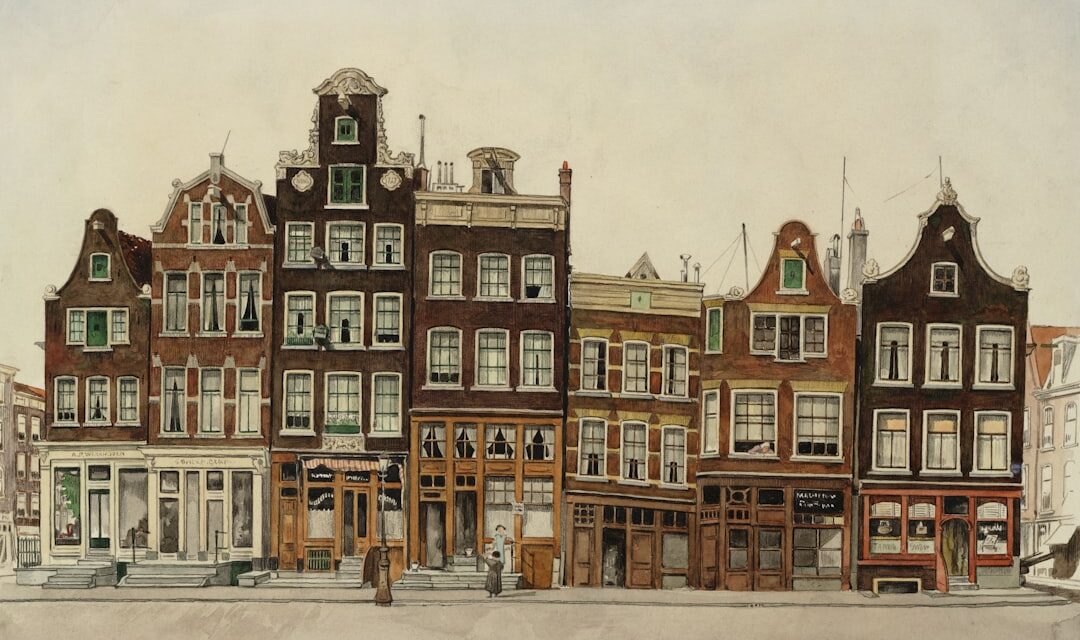Adriaen van Ostade was born in 1610 in Haarlem, a city that was a vibrant centre for the arts during the Dutch Golden Age. His family background is somewhat obscure, but it is believed that he was the son of a painter, which likely influenced his early interest in art. Van Ostade’s formative years coincided with a period of significant cultural and economic growth in the Netherlands, which fostered a flourishing artistic environment.
He was exposed to the works of prominent artists of the time, including Frans Hals and Rembrandt, whose styles would later inform his own artistic development. In 1629, at the tender age of 19, van Ostade became a pupil of the renowned painter, Adriaen Brouwer, who was known for his depictions of peasant life and tavern scenes. This apprenticeship proved pivotal in shaping van Ostade’s artistic vision.
Brouwer’s influence is evident in van Ostade’s early works, which often featured rustic settings and the everyday lives of common folk. The socio-political climate of the time, marked by the Eighty Years’ War and the subsequent peace, provided a rich backdrop for his exploration of genre scenes that captured the essence of Dutch life.
Summary
- Adriaen van Ostade was born in Haarlem, Netherlands in 1610 and came from a family of artists and craftsmen.
- His artistic style was influenced by the works of Rembrandt and he was known for his use of light and shadow in his paintings.
- Adriaen van Ostade’s depictions of peasant life and everyday scenes had a significant impact on Dutch Golden Age art.
- Some of his notable works include “The Peasant Dance” and “The Merry Peasant”.
- He collaborated with other artists and artisans, including his brother Isaac van Ostade, to create genre paintings that captured the essence of everyday life.
Artistic Style and Techniques of Adriaen van Ostade
Adriaen van Ostade’s artistic style is characterised by its vivid realism and attention to detail, particularly in the portrayal of peasant life. His works often feature a warm colour palette, with earthy tones that evoke a sense of authenticity and intimacy. Van Ostade had a remarkable ability to capture the nuances of human expression, which allowed him to convey a wide range of emotions in his subjects.
His figures are often depicted in candid moments, engaged in everyday activities that resonate with viewers on a personal level. In terms of technique, van Ostade employed a meticulous approach to composition and brushwork. He was adept at using chiaroscuro to create depth and dimension within his paintings, skillfully manipulating light and shadow to enhance the three-dimensionality of his subjects.
This technique not only added drama to his scenes but also highlighted the textures of clothing and the rustic interiors he often depicted. His mastery of oil painting allowed him to achieve a luminosity that brought his subjects to life, making them feel almost tangible.
Influence of Adriaen van Ostade on Dutch Golden Age Art
Adriaen van Ostade’s contributions to Dutch Golden Age art cannot be overstated. He played a significant role in popularising genre painting, a style that focused on depicting everyday life rather than historical or religious themes. His ability to elevate the mundane into art resonated with both contemporary audiences and future generations of artists.
Van Ostade’s works often served as social commentaries, reflecting the realities of peasant life while simultaneously celebrating their resilience and humanity. His influence extended beyond his immediate circle; many artists were inspired by his approach to genre scenes.
His legacy is evident in the way subsequent artists embraced the depiction of ordinary life, transforming it into a subject worthy of artistic exploration. Van Ostade’s work helped to establish genre painting as a respected category within the broader context of Dutch art.
Notable Works and Masterpieces of Adriaen van Ostade
Among Adriaen van Ostade’s most notable works is “The Peasant Wedding,” painted around 1660. This masterpiece encapsulates the essence of his artistic vision, showcasing a lively celebration filled with joy and camaraderie. The composition is rich with detail, from the expressions on the faces of the guests to the intricate patterns on their clothing.
The painting serves as both a celebration of peasant culture and a reflection on the social dynamics of the time. Another significant work is “The Interior of a Peasant’s House,” which offers an intimate glimpse into the daily lives of rural folk. The warm light filtering through the window illuminates the scene, highlighting the simplicity yet richness of their existence.
Van Ostade’s ability to capture the essence of domestic life is evident in this piece, as he portrays not just the physical space but also the emotional warmth that characterises these humble abodes. Such works have solidified his reputation as one of the foremost genre painters of his time.
Adriaen van Ostade’s Depiction of Peasant Life
Van Ostade’s portrayal of peasant life is marked by both authenticity and empathy. He did not merely depict peasants as subjects for artistic exploration; rather, he imbued them with dignity and humanity. His works often showcase scenes of communal activities—such as feasting, dancing, or engaging in leisure—highlighting the joy found in simple pleasures despite their challenging circumstances.
This nuanced representation allows viewers to connect with his subjects on a deeper level. Moreover, van Ostade’s attention to detail extends beyond mere aesthetics; he captured the socio-economic realities faced by peasants during his time. His paintings often reflect themes of hard work juxtaposed with moments of respite, illustrating the balance between toil and enjoyment in rural life.
This duality resonates with audiences, inviting them to reflect on their own experiences while fostering a sense of appreciation for the resilience inherent in everyday existence.
Collaboration with other Artists and Artisans
Throughout his career, Adriaen van Ostade engaged in collaborations with various artists and artisans, which enriched his artistic practice and broadened his exposure within the art community. One notable collaboration was with fellow Haarlem painter Frans Hals, whose dynamic brushwork and lively compositions influenced van Ostade’s approach to capturing movement and expression in his own works. Their interactions likely provided opportunities for artistic exchange that contributed to van Ostade’s evolving style.
Additionally, van Ostade collaborated with printmakers who helped disseminate his work beyond Haarlem. The reproduction of his paintings in print form allowed for greater accessibility and appreciation among a wider audience. This collaboration not only enhanced his visibility but also solidified his status as a significant figure within the Dutch art market.
Such partnerships exemplify how artists during this period often relied on one another for support and inspiration, fostering a vibrant artistic community.
Adriaen van Ostade’s Impact on Genre Painting
Adriaen van Ostade is often regarded as one of the pioneers of genre painting, a style that focuses on depicting scenes from everyday life rather than grand historical or religious narratives. His ability to elevate ordinary moments into compelling visual stories has had a lasting impact on this genre. By portraying peasants engaged in their daily routines with warmth and authenticity, he helped to establish genre painting as a legitimate form of artistic expression.
His influence can be seen in the works of later artists who embraced similar themes and techniques. The likes of Jan Steen and Pieter de Hooch drew inspiration from van Ostade’s ability to capture human emotion within domestic settings. This legacy continues to resonate today, as contemporary artists explore themes related to everyday life through their own unique lenses.
Van Ostade’s contributions have thus laid a foundation for future generations to build upon, ensuring that genre painting remains an enduring aspect of art history.
Recognition and Legacy of Adriaen van Ostade
During his lifetime, Adriaen van Ostade garnered considerable recognition for his work, becoming a respected figure within Haarlem’s artistic community. His paintings were sought after by collectors and patrons alike, reflecting both his technical skill and thematic depth. As an influential member of the Haarlem Guild of St Luke, he played an active role in promoting the arts within his city while also mentoring aspiring artists who would go on to make their own marks on the art world.
In terms of legacy, van Ostade’s impact extends far beyond his lifetime. His works continue to be celebrated in major art institutions around the world, where they are studied for their historical significance as well as their artistic merit. The themes he explored—such as community, resilience, and the beauty found in everyday life—remain relevant today, allowing modern audiences to connect with his art on multiple levels.
As such, Adriaen van Ostade is remembered not only as a master painter but also as a pivotal figure in shaping the trajectory of Dutch genre painting.
Adriaen van Ostade’s Use of Light and Shadow in His Art
One of the hallmarks of Adriaen van Ostade’s artistry is his masterful use of light and shadow—a technique known as chiaroscuro—that adds depth and dimension to his compositions. By skillfully manipulating light sources within his paintings, he creates an atmosphere that draws viewers into the scene while highlighting key elements within it. This technique enhances not only the physicality of his subjects but also their emotional resonance.
In many of his works, van Ostade employs warm light filtering through windows or illuminating figures engaged in various activities. This careful consideration of lighting serves to create focal points within each composition while also evoking a sense of intimacy and warmth.
Personal Life and Relationships of Adriaen van Ostade
Adriaen van Ostade’s personal life remains somewhat enigmatic due to limited historical records; however, it is known that he married twice during his lifetime—first to Maria de Vries in 1636 and later to Anna de Vries after her passing. These relationships likely influenced both his personal experiences and artistic output, providing him with insights into domestic life that would inform his depictions of family dynamics within his genre scenes. His connections within Haarlem’s artistic community also played a crucial role in shaping his career trajectory.
As an active member of local guilds and associations, he formed friendships with fellow artists who shared similar interests and aspirations. These relationships fostered an environment conducive to collaboration and mutual support—elements that were essential for artists navigating the competitive landscape of 17th-century Dutch art.
Adriaen van Ostade’s Contribution to the Dutch Art Market
Adriaen van Ostade’s contributions to the Dutch art market were significant during his lifetime and continue to resonate today. His ability to produce high-quality genre paintings made him a sought-after artist among collectors who appreciated both technical skill and thematic depth. As demand for genre scenes grew during the Dutch Golden Age, van Ostade positioned himself as one of its leading practitioners—helping to shape market trends while also influencing public taste.
Moreover, his success paved the way for future generations of artists who sought to explore similar themes within their own work. By establishing genre painting as a respected category within Dutch art, van Ostade contributed not only to its popularity but also its evolution over time. His legacy endures through ongoing scholarship and appreciation for his contributions—ensuring that Adriaen van Ostade remains an integral figure within discussions surrounding Dutch art history and its market dynamics.
For those interested in exploring different art forms, a fascinating article on African art traditions from tribal masks to modern influences is a must-read. This insightful piece delves into the rich history and cultural significance of African art, highlighting the evolution of traditional practices and their impact on contemporary artists. To learn more about the diverse and vibrant world of African art, check out this article today.


